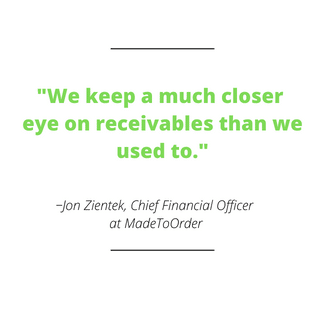Let’s face it: Most of us are not accounting types.
We’re an industry full of creatives and salespeople who speak more in the language of letters, colors, imprints and experiences than we do numbers. So, when it comes to accounting, many of us are either terrified of it or shy away from making it an important part of our weekly and monthly review.
But we all know it’s crucial.
For years, the accounting knowledge in our industry has been hidden behind a veil of mystery, so we decided to open that veil by simply talking with a few friends, experts in the industry, and ask how they are able to keep their eye on the financial health of their businesses.
Jon Zientek is the Chief Financial Officer at MadeToOrder (PPAI 216503, D9), a successful large distributor based in California and an employee-owned enterprise since 2018. Jon is highly respected by his peers for his financial acumen and leadership. We asked him, “What are a few of the primary KPIs you keep an eye on when it comes to maintaining a strong financial business?” Zientek shared four different KPIs, two of the critical ones we’ve unpacked below to give you a quick formula to measure your business health:
The Working Capital Ratio
Most of us are making prepayments to vendors or juggling terms with vendors, plus a long production cycle, and then juggling terms with clients. Often, a project can go from an order to invoice and final payment from the client in the span of six weeks. We’re even sometimes making prepayments to vendors while waiting for cash to come from customers. Those time frames require a delicate balance of managing the flow of cash through your business.
We mentioned this in our previous post about recession-proofing your business, but JP Morgan Chase produced a massive research report surveying over 600,000 small businesses and discovered that the average number of days a small business could pay out of its cash reserve is about one month. JP defined this as “cash buffer days,” the number of days a business can pay out of its cash if its inflows were to stop. According to JP, on average, businesses are substantially more resilient if they hold a reserve of 62 days or more while many experts say that a reserve of three to six months of current operating expenses is optimal. 
A working capital ratio is the money your business can tap into to meet your daily financial obligations.
Current asset examples are your cash-at-bank and accounts receivable. Current liabilities are your accounts payable/supplier payments, payroll, rent, outstanding expenses, etc. The formula (working capital ratio = current assets/current liabilities), according to American Express, “shows how many times a company can pay off its current liabilities with its current assets.”
American Express uses an example: “If a company’s balance sheet has $300,000 total current assets and $200,000 total current liabilities, the company’s working capital ratio = 1.5. Generally speaking, a ratio of less than 1 can indicate future liquidity problems, while a ratio between 1.2 and 2 is considered ideal.” If the ratio is too high (i.e. over 2), it could signal that the company is hoarding too much cash, instead of investing it back into the business to fuel growth.”
A working capital ratio gives you and your leadership team a quick formula, and the more you calculate this translation through the cycles of your business, the more effectively you’ll learn to make decisions based on current cashflow, future investments, and a way to mentally think through preparedness.
Overhead Costs As A Percentage Of Sales
Most of us are accustomed to monitoring gross profit margin. Zientek advises we should always keep an eye on gross profit margin, but especially keep an eye on what he calls “net profit margin” or “margins after commissions.” Watching net margins after commissions is critical because that’s the money that pays for your operating expenses and the money that the company gets to keep.
Most distributors let their sales reps set pricing, but one danger area to watch over is the temptation to chase new business or secure large orders by lowering margins to a dangerous level. To a salesperson, overhead cost is basically zero (compared to the company that has fixed costs like rent, payroll, and more) so the temptation to drop percentage points is always looming. But the company must keep an eye on profitability and operating costs after commissions.
To quickly monitor your profitability and how sales are impacting your operating expenses, consider calculating your overhead costs as a percentage of sales. An easy way to find this is to divide your monthly overhead cost by your monthly sales and multiply that by 100. The formula would be:
- Monthly overhead costs ÷ monthly sales x 100 = your percentage of overhead costs
- Example: ($12,500/$50,000) ✕ 100 = 25% overhead
Overhead costs come in two primary categories: fixed overhead expenses like rent, utilities, insurance, salaries, etc., and variable costs like office supplies, marketing expenses, and more. A simple example: renewing your business insurance or healthcare insurance could be met with a skyrocketing increase and these costs are fixed. It’s important to be able to calculate a formula to figure out what percentage of each dollar goes toward covering your overhead costs, which can fluctuate as the business grows.
According to Square, “as a general rule, it’s best to make sure your business doesn’t exceed a 35% overhead rate, but there’s no cut-and-dried answer to what your overhead should be.”
Two other key areas Zientek watches over religiously are receivables and payables. “We keep a much closer eye on receivables than we used to,” he says. “We implemented certain practices and set up KPIs to ensure we are reigning in receivables. Quickbooks can help you establish those KPIs, but you have to keep watch on your receivables and make sure you are paying your vendors on time.” Setting up benchmarks for both is a solid way to ensure you are staying on goal.
This article is brought to you by commonsku, the work-from-anywhere platform that powers your connected workflow enabling you to process more orders and dramatically grow your sales. To learn more visit commonsku.com.


